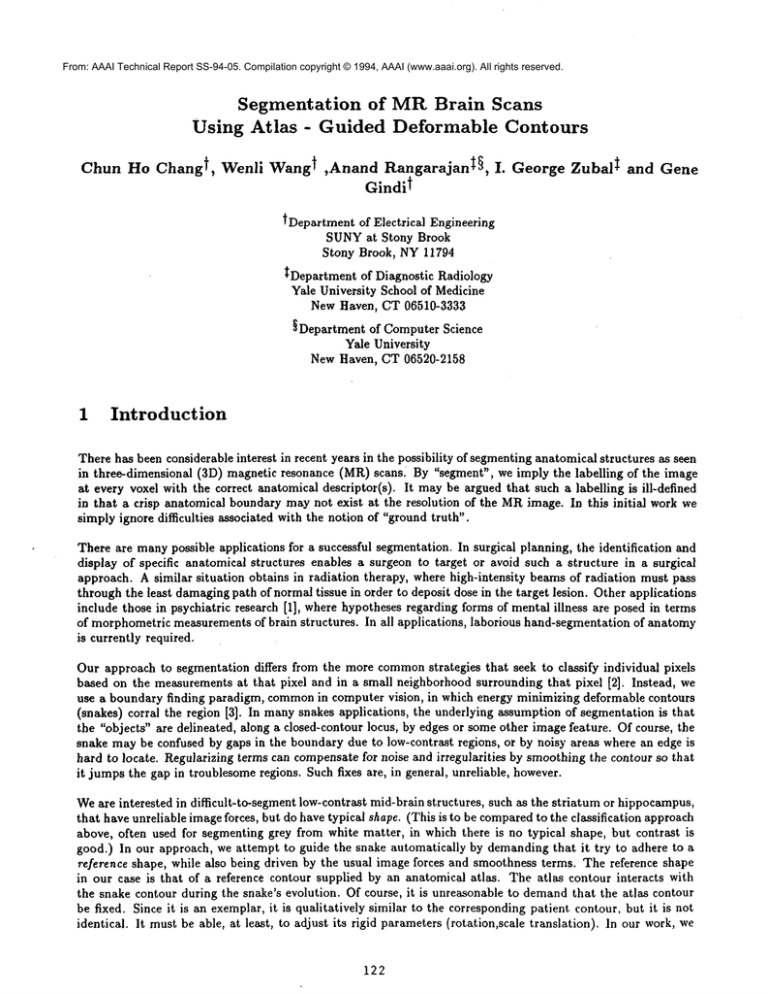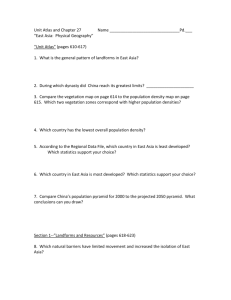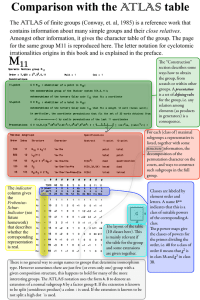
From: AAAI Technical Report SS-94-05. Compilation copyright © 1994, AAAI (www.aaai.org). All rights reserved.
Segmentation
of
Using Atlas - Guided
MR Brain Scans
Deformable
Contours
Chun Ho Changt, Wenli Wangt ,Anand Rangarajan~§, I. George Zubal$ and Gene
Gindit
~Department of Electrical Engineering
SUNYat Stony Brook
Stony Brook, NY 11794
~Department of Diagnostic Radiology
Yale University School of Medicine
New Haven, CT 06510-3333
§Department of Computer Science
Yale University
New Haven, CT 06520-2158
1
Introduction
There has been considerable interest in recent years in the possibility of segmenting anatomical structures as seen
in three-dimensional (3D) magnetic resonance (MR) scans. By "segment", we imply the labelling of the image
at every voxel with the correct anatomical descriptor(s). It maybe argued that such a labelling is ill-defined
in that a crisp anatomical boundary may not exist at the resolution of the MRimage. In this initial work we
simply ignore difficulties associated with the notion of "ground truth".
There are manypossible applications for a successful segmentation. In surgical planning, the identification and
display of specific anatomical structures enables a surgeon to target or avoid such a structure in a surgical
approach. A similar situation obtains in radiation therapy, where high-intensity beams of radiation must pass
through the least damagingpath of normal tissue in order to deposit dose in the target lesion. Other applications
include those in psychiatric research [1], where hypotheses regarding forms of mental illness are posed in terms
of rnorphometric measurements of brain structures. In all applications, laborious hand-segmentation of anatomy
is currently required.
Our approach to segmentation differs from the more commonstrategies that seek to classify individual pixels
based on the measurements at that pixel and in a small neighborhood surrounding that pixel [2]. Instead, we
use a boundary finding paradigm, commonin computer vision, in which energy minimizing deformable contours
(snakes) corral the region [3]. In manysnakes applications, the underlying assumption of segmentation is that
the "objects" are delineated, along a closed-contour locus, by edges or some other image feature. Of course, the
snake may be confused by gaps in the boundary due to low-contrast regions, or by noisy areas where an edge is
hard to locate. Regularizing terms can compensate for noise and irregularities
by smoothing the contour so that
it jumps the gap in troublesome regions. Such fixes are, in general, unreliable, however.
Weare interested in difficult-to-segment low-contrast mid-brain structures, such as the striatum or hippocampus,
that have unreliable image forces, but do have typical shape. (This is to be comparedto the classification approach
above, often used for segmenting grey from white matter, in which there is no typical shape, but contrast is
good.) In our approach, we attempt to guide the snake automatically by demanding that it try to adhere to
reference shape, while also being driven by the usual image forces and smoothness terms. The reference shape
in our case is that of a reference contour supplied by an anatomical atlas. The atlas contour interacts with
the snake contour during the snake’s evolution. Of course, it is unreasonable to demandthat the atlas contour
be fixed. Since it is an exemplar, it is qualitatively similar to the corresponding patient contour, but it is not
identical. It must be able, at least, to adjust its rigid parameters (rotation,scale translation). In our work,
122
allow even more variation; the atlas is allowed to undergo, with no cost, an arbitrary affine transform. This
compromisebetween rigidity and flexibility for the atlas contour constitutes an initial attempt to tradeoff bias
vs. variance in the model for the anatomical region.
2
Snake - Atlas
Model
The snake v(s) provides the set of locations corresponding to a loci of high intensity gradients. This set
locations v(s) = (x(s), y(s)), Y s E S is represented as a single closed curve and is parametrized by an
arc length parameter s. A second contour, the atlas contour, interacts with the snake, but not with the image.
Its initial postion is exactly coincident with that of the snake, and in a discrete representation, a pointwise
correspondence exists for the atlas and snake. Wedistinguish the initial atlas w(s), which is a constant that
remains fixed, with the local atlas a(s) that evolves along with the snake.
The update takes place in alternating phases: First the snake, attracted by image, smoothness, and local atlas
forces, moves incrementally. Then the initial atlas is updated to compute the next local atlas by warping it
through aa optimal affine transform. The affine transform is computed as that transform which minimizes the
square distance between initial atlas points and corresponding snake points.
The snake dynamically evolves due to the action of three forces; (i) the image intensity
smoothness constraints and (iii) adherence to the local atlas. This can be written
gradients,
(ii)
dv
d--’~ = Iv(v(s))Ivv(V(S))
where the term Iv(V(S))Ivv(V(S))
+ c~vs, +/~v,,,,
(1)
+ 7(a(s) - v(s))
denotes a vector formed by the components (I~I~, l~Iy~).
As mentioned previously, the initial atlas w(s) is continuously deformed via the action of the affine warp A
give an incremental (local) atlas a(s) = Aw(s).
a2
=
A4
A5
As
(1)
(2)
w2
This two-phase procedure results in a dynamic evolution of the snake and the warping matrix. Finally,
two-phase alternating procedure can be shown to perform coordinate-wise descent on the energy function
E(v(s))
=
IIX( (s)l ds + ~
~
",,
~
- a()ll ds.
the
(3)
The above energy function is just a restatement of the action of the various forces in terms of potentials.
(Equation 1 is simply the Euler-Lagrange equation for this energy.) The first term on the right of (3) expresses
the image gradient energy and is minimized at locations with a high intensity gradient. The second and third
terms are the first and second order stiffness potentials with corresponding parameters ot and/3. The final term
is the snake-incremental atlas matching energy. Note that the incremental atlas a(s) is a function of the initial
atlas w(s) via the warp matrix A. It is the estimation of the warp after the current state of evolution of the
snake v(s) that contributes most to the two-phase alternating procedure. Note als6 that the atlas warp is "free":
there is no energy charge for this. Dynamicsterminate at somereasonable stopping criterion.
3
Initializing
the Contours
The snake and atlas have to be reasonably well postioned initially in order to be effective. The segmentation
begins with a 3D patient image, and a digitized 3D anatomical atlas. Our 3D anatomical atlas is essentially the
123
MRscan of a single, probably normal, subject (actually, our systems administrator). Anatomical contours, hand
traced and labelled by experts in each 2D slice, are stored in the atlas reference frame. Along with contours,
the locations of unambiguous anatomical point landmarks are stored. In order to register the atlas coordinate
frame and the patient frame, we mark the corresponding point landmarks in the patient image, and calculate
an optimal geometrical 3D coordinate warp to bring the landmarks into correspondence. Currently, we use a
3D affine transform. The patient image is then resliced derive 2D patient sections corresponding to the 2D atlas
slices. The atlas contour of interest is then simply mappedto the 2D patient slice to form w(s) and the initial
location of v(s). The subsequent snake algorithm can, in fact, be viewed as a refinement in this initial contour
location.
4
Results
Figure 1 illustrates initial results obtained in segmenting an anatomical region, knownas the putamen, as seen
in a Tl-weighted MRslice. As shown in Figure l(c), we simply initialized
the snake by hand (white contour)
and attempted to have it find a ground-truth goal (black) contour as drawn by an expert. In this manner,
could evaluate the success/failure of the snake. Figure l(b) shows the image forces (gradients) in the region
concern. Comparison of the black contour of Fig. l(c) and the corresponding region in Fig. lib ) shows that
the image forces are weak or missing in this low contrast region. In Fig. l(d) we show the result of using
conventional snake (white contour) and atlas-guided snake (black contour). Comparison to Figure l(c)
the beneficial effect of the atlas guidance. Note that the two cases differed only by inclusion of the atlas term in
the energy function. All parameters and initial positions were otherwise identical.
Results with synthetic images in Figure 2 illustrate more explicitly the benefits of atlas guidance. Figure 2(a) was
created by synthesizing a binary ellipse, then shading it and blurring it by a Gaussian kernel (5 pixel standard
deviation). The boundary of the original ellipse is the black contour, which serves as the goal contour. The
256x256image also contains a smaller "decoy" ellipse in the upper left corner. The initial contour and atlas were
obtained by rotating the goal contour by 5 degrees, scaling it in z and y by a factor of 1.1, and translating it 2
pixels up and 2 pixels to the left. Figure 2(b) shows the results of a conventional snake (white contour) and atlas
(black contour). The snake has been incorrectly attracted by the relatively strong gradient in the nearby decoy,
while the atlas guidance has beneficially steered the black contour away from this temptation. Figure 2(c),
256x256image, was created by taking a binary rectangle, chopping off the lower right corner, and blurring it as
was done for the ellipse. The black contour outlines the original rectangle and again serves as our goal contour.
The initial snake and atlas were obtained by transforming the goal contour exactly as in the previous case. Figure
2(d) shows results. The ordinary snake (white contour) adheres to the missing corner, but atlas guidance results
in the black contour "filling in " the missing corner. One might also note that the conventional snake, because
of the stretching and bending energy forces, rounds off the three remaining corners of the grey scale image. The
atlas guided snake, with identical smoothing parameters, more faithfully captures these corners.
References
[1] N. Andreasen, "Brain Imaging: Applications in Psychiatry",
Science, vol. 239, pp. 1381-1388, March 1988.
[2] J. Bezdek, L. Hall, and L. Clarke, "Review of MRSegmentation Techniques Using Pattern Recognition",
Medical Physics, 20, pp. 1033-1048, 1993.
[3] M. Kass, A. Witkin, and D. Terzopoulos, "Snakes: Active Contour Models", Intl.
pp. 321-331, 1988.
124
J. Computer Vision, 1,
(a)
(b)
(c)
(d)
Figure 1: (a) original MRimage.(b) gradient mapof region of interest. (c) white contour is the initial snake,
contour is drawnby physician. (d) Darkcontour is atlas guided snake result and white contour is conventional
snake.
(d)
Figure 2: (a),(c) are target contours. (b),(d) are final contours. Darkcontour is the atlas guidedsnake
white contour is the conventionalsnake.
125




